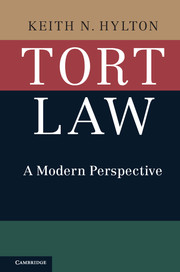Book contents
- Frontmatter
- Contents
- 1 Introduction
- 2 Policy and Tort Law
- 3 Evolution of Tort Law
- 4 Intentional Torts
- 5 Theoretical Foundations of Strict Liability
- 6 The Reasonable Person
- 7 Customs, Statutes, and the Reasonable Person
- 8 Inferring Negligence
- 9 Contributory Negligence and Assumption of Risk
- 10 Contributory Negligence, Comparative Negligence, and Incentives for Care
- 11 Joint and Several Liability, and Vicarious Liability
- 12 Factual Causation
- 13 Proximate Cause
- 14 Duty to Rescue and Special Relationships
- 15 Strict Liability: Conversion, Abnormally Dangerous Activities, and Nuisance
- 16 Defamation
- 17 Products Liability
- 18 Damages
- Index
5 - Theoretical Foundations of Strict Liability
Published online by Cambridge University Press: 05 June 2016
- Frontmatter
- Contents
- 1 Introduction
- 2 Policy and Tort Law
- 3 Evolution of Tort Law
- 4 Intentional Torts
- 5 Theoretical Foundations of Strict Liability
- 6 The Reasonable Person
- 7 Customs, Statutes, and the Reasonable Person
- 8 Inferring Negligence
- 9 Contributory Negligence and Assumption of Risk
- 10 Contributory Negligence, Comparative Negligence, and Incentives for Care
- 11 Joint and Several Liability, and Vicarious Liability
- 12 Factual Causation
- 13 Proximate Cause
- 14 Duty to Rescue and Special Relationships
- 15 Strict Liability: Conversion, Abnormally Dangerous Activities, and Nuisance
- 16 Defamation
- 17 Products Liability
- 18 Damages
- Index
Summary
The fundamental components of modern tort law are strict liability and negligence. The focus of this chapter is strict liability, as developed in Rylands v. Fletcher. As in the previous chapter, I will continue to develop a functional account of tort doctrine. In particular, I will try to explain the purpose and limits of strict liability from an instrumentalist perspective. Of course, any theory that explains the scope of strict liability should also be capable of explaining the scope of negligence, or precisely when negligence liability ends and strict liability begins.
The first part of this chapter (sections I and II) presents the Rylands doctrine and an instrumentalist justification for it. The second part (section III) extends the theory of Rylands to provide a justification for the boundary between strict liability and negligence as well as the boundary between negligence and tort immunity.
RYLANDS V. FLETCHER
Ancient coal mine shafts ran beneath the surface of the adjacent properties of the defendant and the plaintiff. These shafts were filled with soil, so their paths would not have been immediately clear to anyone who found them while excavating. The defendant built a reservoir. The water from the reservoir burst through the shafts, flooding the plaintiff's property.
Engineers employed by the defendant became aware of the ancient shafts as they were constructing the reservoir. However, they did not know how far the shafts extended. Although there was evidence suggesting that the engineers did not use proper care, this was inconclusive.
One of the issues in the lawsuit was whether the defendant was guilty of a trespass. Trespass, recall, involves the intentional invasion of another's property. The kind of intent required for trespass is simply an intention to invade, not necessarily to do any harm to the plaintiff.
Was this a case of trespass? How would a plaintiff present a credible trespass theory? To do so, the plaintiff would have to argue that the defendant knowingly sent the water over to his property. That would imply the defendant was aware of the ancient shafts and filled them with water knowing with substantial certainty that the water would flood the plaintiff's land.
- Type
- Chapter
- Information
- Tort LawA Modern Perspective, pp. 91 - 101Publisher: Cambridge University PressPrint publication year: 2016



